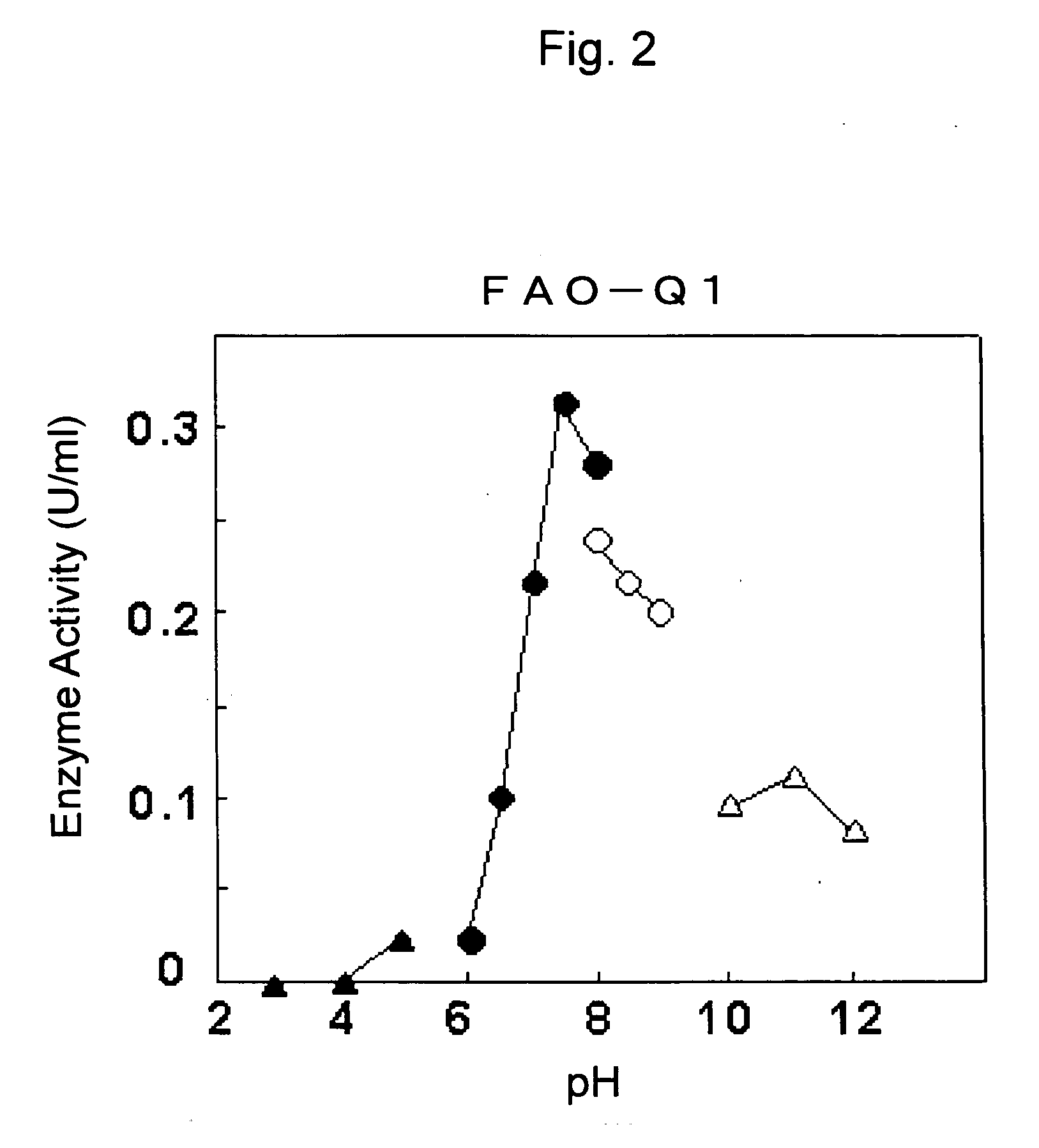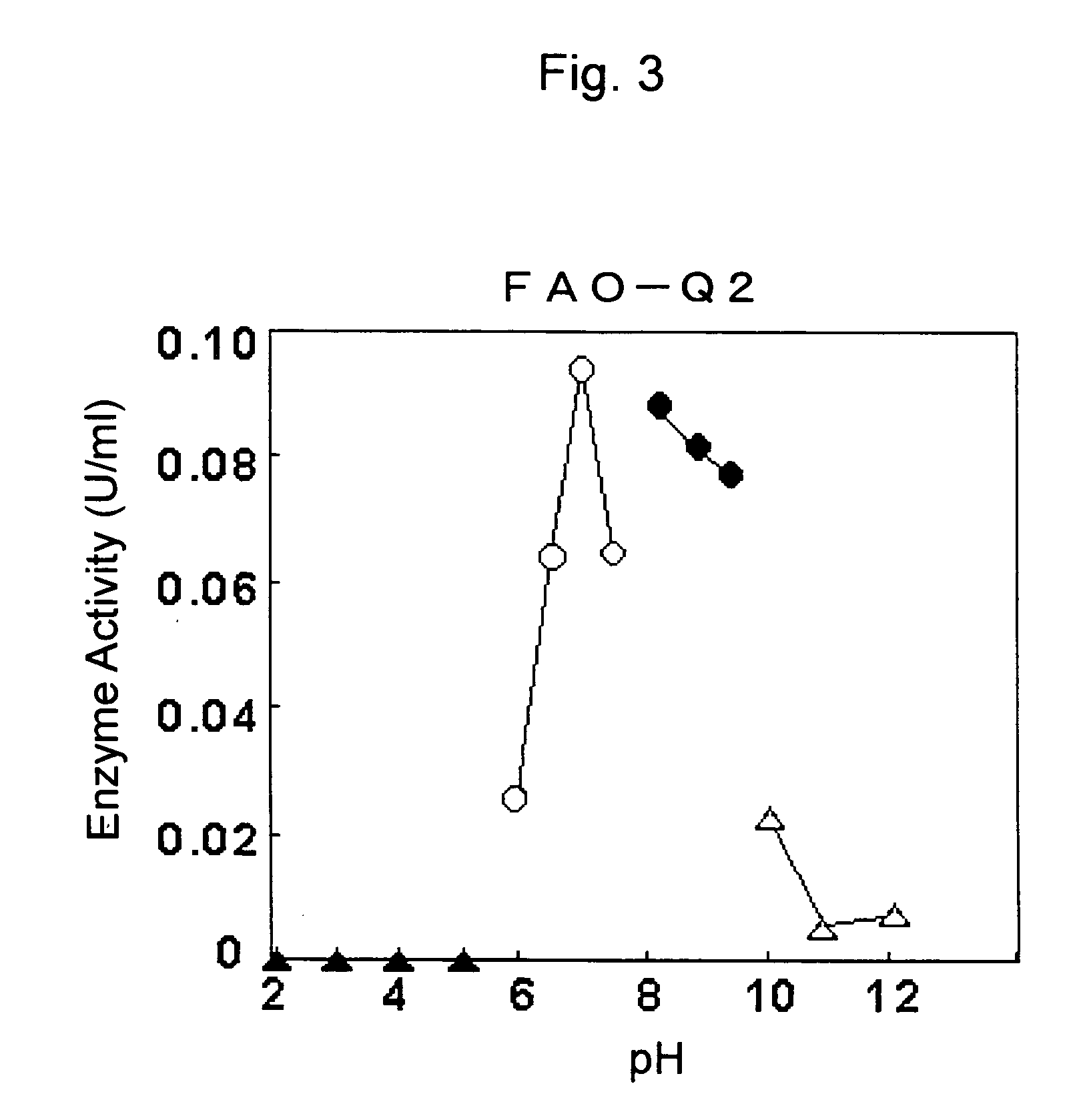Fructosylamine oxidase
- Summary
- Abstract
- Description
- Claims
- Application Information
AI Technical Summary
Benefits of technology
Problems solved by technology
Method used
Image
Examples
example 1
Screening and Identification of Microorganisms Producing FAO
(1) Screening of Microorganisms Producing FAO
[0069] Fructosyl valine-histidine-leucine (FVHL) which is the same as the N-terminal sequence of glycohemoglobin β chain was prepared by glycosylation of VHL. A method therefor is known to those skilled in the art.
[0070] FVHL-assimilating microorganism was isolated from soil using a medium (FVHL medium) containing FVHL as the sole carbon and nitrogen sources. Collected soil was added into 5 ml of FVHL medium in a test tube (16.5 mm in diameter), and cultured with shaking (300 rpm) at 30° C. for 48 hours.
FVHL mediumFVHL5gK2HPO41gNaH2PO41gMgSO4.7H2O0.5gCaCl2.2H2O0.1gVitamin mixture *0.1%(v / v)Metal solution **1.0%(v / v)Distilled waterq.s.Total volume1,000ml*Vitamin mixtureThiamine HCl1mgRiboflavin2Calcium pantothenate2Pyridoxine HCl2Biotin0.1p-Aminobenzoic acid1Nicotinic acid2Folic acid0.1Distilled waterq.s.Total volume100ml** Metal solutionMnSO4.3H2O1.7gZnSO4.7H2O2.2CuSO4.5H2O...
example 2
Preparation of FAO Using GL2-1 and Identification of the Same
(1) Partial Purification of FAO
1) Cultivation and Preparation of Cell-Free Extract
[0087] A GL-2 strain identified in Example 1 was cultured in 100 ml of GV browning medium as described in Example 1 (2) under the same medium composition and culture condition.
[0088] After cultivation, mycelia were collected by filtering the culture medium through a filter. The resultant mycelia (0.6 g) were suspended in 0.1 M Tris-HCl buffer (pH 8.0) containing 1 mM DTT, ground with Mini-BeadBeater™ (glass beads 0.5 mm), and centrifuged (4° C., 10,000×g, 10 minutes) to obtain the supernatant as a cell-free extract.
2) Ammonium Sulfate Fractionation
[0089] Cell-free extract obtained in 1) was subjected to ammonium sulfate (30-80% saturation) fractionation by dissolving in 50 mM Tris-HCl buffer (pH 8.0) containing 1 mM DTT and dialyzing against the same buffer.
3) Resource Q Column Chromatography
example 3
Cloning of FAO cDNA
[0107] Genomic DNA of GL2-1 was prepared. FAO cDNA was then obtained by PCR using as a template the genomic DNA.
(1) Preparation of Genomic DNA of GL2-1 Strain
[0108] The genomic DNA was prepared from GL2-1 strain according to a process comprising the following steps.
[0109] 1. GL2-1 strain is liquid-cultured in 15 ml of DP medium (1% Dextone, 1% Peptone and 0.5% NaCl, pH 7.4) at 30° C. for 2 to 3 days.
[0110] 2. Fungal cells (wet weight, 0.3 g) are collected by filtration through glass filter (3GL).
[0111] 3. The resultant fungal cells are homogenized in a mortar containing liquid nitrogen with a pestle, further ground in a motor or the like, and then collected in a Corning tube. 4. After adding 2 ml of ice-cold TE buffer (10 mM Tris-HCl (pH8.0), 1 mM EDTA), the mixture is vortexed lightly.
[0112] 5. After adding 2 ml of a solution of 50 mM EDTA and 0.5% SDS, the mixture is stirred by rotating several times and incubated at 37° C. for 30 minutes.
[0113] 6. The ...
PUM
| Property | Measurement | Unit |
|---|---|---|
| Temperature | aaaaa | aaaaa |
| Atomic weight | aaaaa | aaaaa |
| Atomic weight | aaaaa | aaaaa |
Abstract
Description
Claims
Application Information
 Login to View More
Login to View More - R&D
- Intellectual Property
- Life Sciences
- Materials
- Tech Scout
- Unparalleled Data Quality
- Higher Quality Content
- 60% Fewer Hallucinations
Browse by: Latest US Patents, China's latest patents, Technical Efficacy Thesaurus, Application Domain, Technology Topic, Popular Technical Reports.
© 2025 PatSnap. All rights reserved.Legal|Privacy policy|Modern Slavery Act Transparency Statement|Sitemap|About US| Contact US: help@patsnap.com



